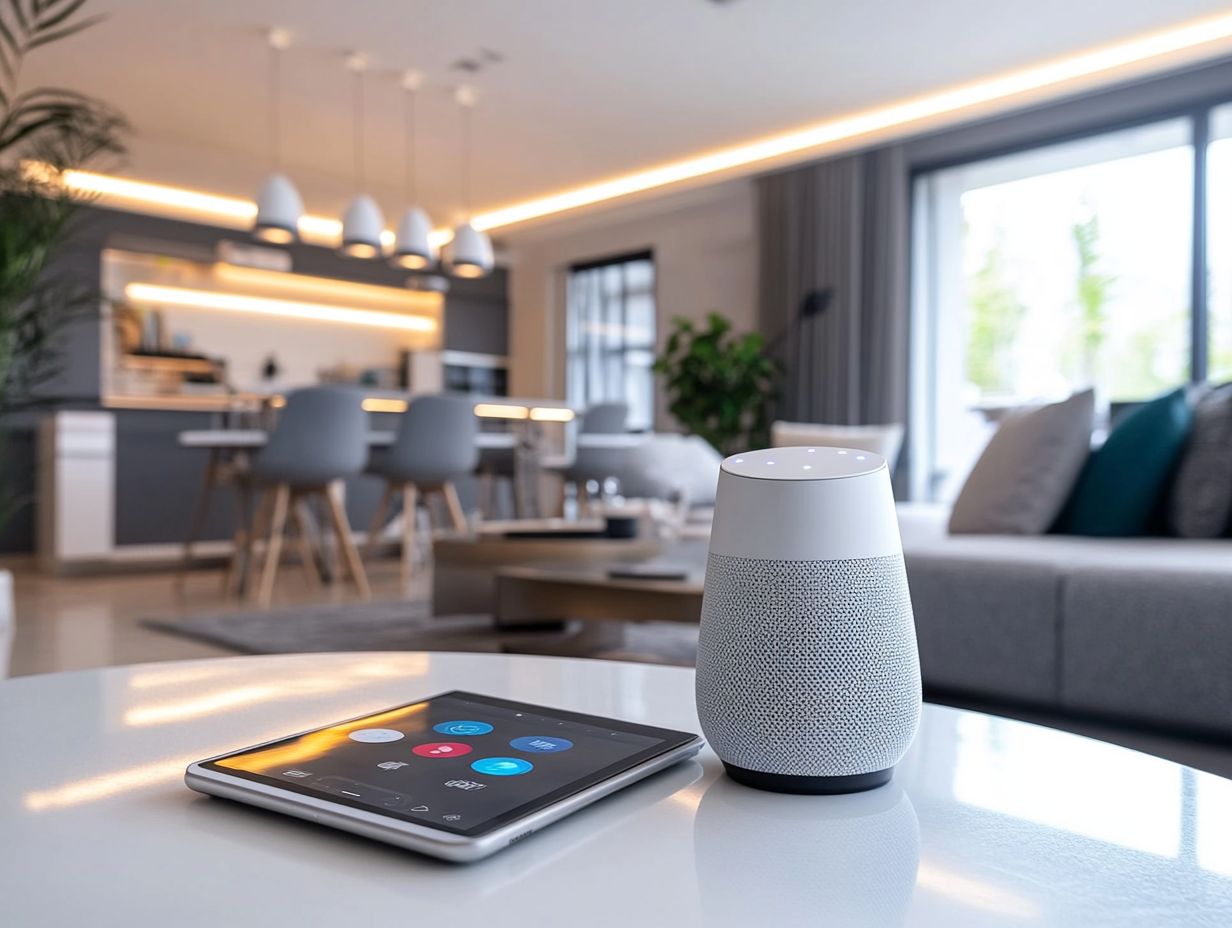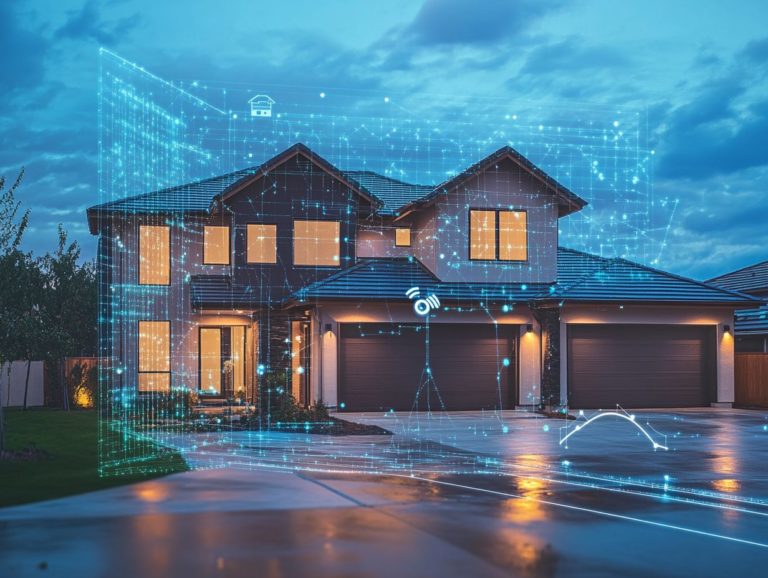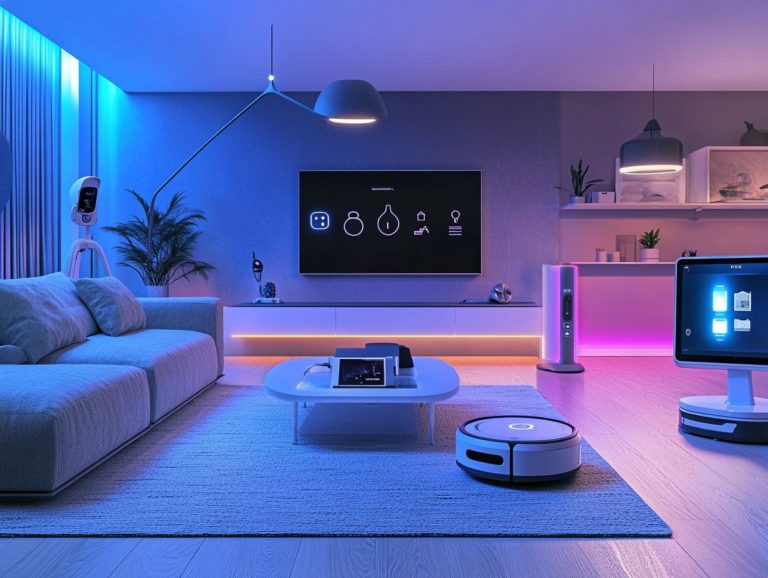How to Create a Smart Home Ecosystem
In today’s digital landscape, the notion of a smart home ecosystem has revolutionized how you engage with your living spaces.
Picture a home where devices communicate effortlessly. This elevates your comfort, security, and energy efficiency to new heights.
This article delves into the essentials of smart home ecosystems. It covers everything from their definition and benefits to crucial components and expert advice on building one.
Discover exciting tips to keep your smart home running at its best and gaze into the thrilling future of this ever-evolving technology.
Dive in to learn how to create a smarter, more connected home tailored just for you.
Contents
- Key Takeaways:
- What is a Smart Home Ecosystem?
- Benefits of a Smart Home Ecosystem
- Components of a Smart Home Ecosystem
- Building Your Smart Home Ecosystem
- Managing and Maintaining Your Smart Home Ecosystem
- Future of Smart Home Ecosystems
- Frequently Asked Questions
- What is a smart home ecosystem?
- What are the benefits of creating a smart home ecosystem?
- What devices can be included in a smart home ecosystem?
- How do I start creating a smart home ecosystem?
- Do I need to have technical knowledge to create a smart home ecosystem?
- Can I add new devices to my smart home ecosystem over time?
Key Takeaways:

A smart home ecosystem is a network of connected devices and technologies that work together to automate and enhance various aspects of daily life, and learning how to optimize your smart home setup can significantly improve your experience.
Homeowners can benefit from a smart home ecosystem through increased convenience, efficiency, and security, as well as potential cost savings.
To create a smart home ecosystem, start by identifying essential devices and technologies. For detailed instructions, check out this guide on how to set up a smart home system. Then plan and set up a network, and regularly maintain and update the system for optimal performance.
What is a Smart Home Ecosystem?
A smart home ecosystem is your gateway to an interconnected network of smart devices. For those looking to enhance their space without breaking the bank, learning how to set up a smart home on a budget allows you to automate and manage numerous aspects of your living environment with ease.
This advanced system promotes convenience, efficiency, and security in your daily life.
Imagine using smart speakers like Google Home or Amazon Alexa as your voice assistants. They allow you to effortlessly control a myriad of smart devices.
Apple HomeKit integrates various devices under one cohesive platform, elevating your user experience to new heights.
Defining the Concept
Defining your smart home ecosystem means grasping how smart devices collaborate for seamless home automation. To learn more about how to implement smart home technology, this ultimately enhances your daily living experience with features like smart lighting and voice assistants.
These interconnected devices create an environment tailored to your individual preferences and routines. For example, you can program a smart lighting system like Philips Hue to adjust brightness and color according to the time of day.
With integrated voice assistants like Alexa and Google Assistant, you can control your lighting with nothing more than a simple command.
Smart thermostats work tirelessly to optimize energy usage, adding another layer of efficiency to your household.
Together, these technologies streamline your daily tasks, making life not just more convenient but truly efficient.
Benefits of a Smart Home Ecosystem
A smart home ecosystem presents you with a wealth of advantages. It enhances energy efficiency, elevates your security settings, and introduces automation routines that streamline your daily tasks.
This makes home management effortlessly convenient and transforms your living space into a sanctuary of comfort and efficiency.
Advantages for Homeowners
You can unlock remarkable advantages from a smart home ecosystem. Experience unparalleled convenience, heightened security measures, and robust digital protection.
These benefits come to life in everyday applications that truly transform how you live.
For example, the ability to remotely monitor your security settings means you can keep a vigilant eye on your property from anywhere. This provides peace of mind no matter your location.
Effortless device setup allows you to seamlessly integrate various gadgets into your living space.
This makes technology accessible even for those who aren t particularly tech-savvy.
Controlling home features through smart speakers boosts convenience and enhances the efficiency of your daily routines, underscoring the importance of both security and ease in modern living.
Components of a Smart Home Ecosystem

The components of a smart home ecosystem encompass a diverse range of smart devices. This includes sophisticated hubs for centralized control and communication standards like Matter, a protocol that helps different devices work together, as well as Bluetooth technology.
Together, these elements collaborate seamlessly to form a cohesive and integrated network.
Ready to start building your smart home ecosystem? Take the first step today!
Essential Devices and Technologies
Essential devices in your smart home include smart speakers like Google Assistant and Amazon Alexa, as well as innovative smart lighting solutions.
Take Philips Hue smart lights, for example. They let you customize your space’s ambiance with different colors and brightness, all controlled by voice commands or smartphone apps.
Smart speakers do more than play music. They serve as central control hubs, helping you communicate with your lights, thermostats, and security cameras.
This integration means you can manage complex tasks easily. Schedule lights to turn on at sunset or adjust the thermostat from your couch.
This synergy creates a functional and convenient environment, making everyday living more enjoyable and efficient.
Building Your Smart Home Ecosystem
Building your smart home ecosystem requires careful planning. Start by selecting the right devices and ensuring your router is set up correctly.
Establish automation routines that will optimize your living space. This ensures everything works smoothly together.
Step-by-Step Guide
Start by choosing compatible smart devices that meet the latest Wi-Fi standards. This choice is crucial for creating an integrated system.
Next, install your devices in optimal positions for the best performance. Make sure they’re well-connected to your home network.
After installation, configure each device using its app. Ensure compatibility with the Matter standard, which helps devices from different brands work together.
Create automation routines to enhance convenience and energy efficiency. This will help all components work in harmony.
Managing and Maintaining Your Smart Home Ecosystem
Managing your smart home ecosystem is vital for optimal performance. Ensure your devices operate in harmony to enhance functionality and protect your privacy.
Tips for Optimal Performance

To achieve optimal performance, troubleshoot your devices regularly. Stick to digital security measures to keep your home safe.
Routine updates enhance functionality and prevent issues. Keep an eye out for firmware updates they often include improvements and security patches.
Use effective troubleshooting techniques like restarting devices. Check connections to resolve minor glitches before they grow into bigger problems.
Establish a secure network with strong passwords and enable two-factor authentication. This shields you from potential threats.
Follow these recommendations for a seamless and secure smart home experience. Let technology work harmoniously without frequent interruptions.
Future of Smart Home Ecosystems
The future of smart home ecosystems is bright, driven by new technologies. These innovations will create interconnected and intelligent living spaces.
Emerging Technologies and Trends
Emerging technologies in smart home ecosystems, such as advanced automation and enhanced privacy policies, are transforming how you engage with smart devices in your daily life.
These innovations streamline your everyday tasks while granting you greater control over your personal information. For example, artificial intelligence is being woven into smart home systems to learn your preferences, effortlessly adjusting lighting, temperature, and security protocols to suit your needs.
At the same time, cutting-edge encryption methods are being developed to safeguard your personal data against potential threats. As these technologies evolve, their impact on your experience is remarkable, creating a more intuitive and seamless interaction with your home while prioritizing your privacy and security.
Frequently Asked Questions
What is a smart home ecosystem?
A smart home ecosystem is simply a group of devices in your home that work together and can be controlled from one app or hub.
What are the benefits of creating a smart home ecosystem?

A smart home ecosystem offers convenience, energy efficiency, security, and improved accessibility for individuals with disabilities or limited mobility.
What devices can be included in a smart home ecosystem?
Smart home ecosystems can include a variety of devices such as smart lights, thermostats, security systems, speakers, appliances, and more.
How do I start creating a smart home ecosystem?
The first step is to choose a central hub or system, like Amazon Echo, Google Home, or Apple HomeKit, and then start incorporating compatible devices into your home.
Do I need to have technical knowledge to create a smart home ecosystem?
No, you do not need technical knowledge. Most smart home devices are designed to be user-friendly and can be set up and controlled through a smartphone app.
Can I add new devices to my smart home ecosystem over time?
Yes, you can continuously add new devices to your smart home ecosystem as long as they are compatible with your central hub or system.






